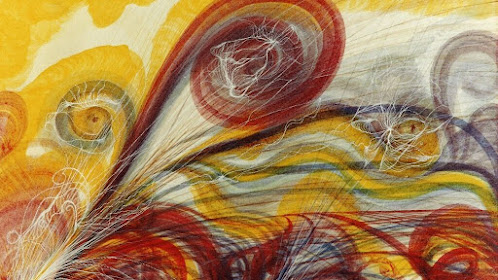21 March 2023
Georgianna Houghton: Things of the Spirit
17 March 2023
Hilma af Klint: A Cartography of the Spirit
"Land lies in water; it is shaded green.
Shadows, or are they shallows, at its edges
showing the line of long sea-weeded ledges
where weeds hang from the simple blue to green.
Or does the land lean down to lift from under.
drawing it unperturbed from itself?
Along the fine tan sandy shelf
is the land tugging at the sea from under?"
- excerpt from "The Map" by Elizabeth Bishop, from North and South (1934)f
To me, Seven-Pointed Star looks like nothing so much as a map. Knowing that Hilma af Klint was born into a family of naval officers and cartographers, the comparison seems spot on. She spent her entire life pondering in monumental paintings. the spiritual dimensions of science.
She was a member of the second generation of women who were allowed to study at the Royal Academy of Art in Stockholm where she was able to sketch male nudes in life class. What were considered unseemly activities for a woman interested af Klint not at all. She traveled far and wide, visiting Norway, Germany, Holland, Belgium, and London. Not everyone was accepting of those female students.
"It takes a man to create a Parthenon frieze or paint the Sistine Chapel."
"Woman must go. Immediately. Has a single one of these weak women at the Academy become an artist? For me there is not one who has any value at all." - 1889
These misogynistic comments came from fellow Swede Carl Larsson, an artist known for idyllic scenes of family life.
Klinr spent her entire life pondering the fundamental conditions of existence in monumental paintings. Her ideal building was a spiral; she would have been thrilled with the Guggenheim Museum's retrospective of her work and that the exhibition single-handedly changed the shape of art history.
Image: Hilma af Klint - Group V, Series, Seven-Pointed Star, Moderna Museet, Stockholm.
08 March 2023
Sylvia Sleigh: The Group
Image: Sylvia Sleigh - A.I. R. Group Portrait, 1977-1978, oil on canvas, Whitney Museum, NYC
03 March 2023
Winter Trees: Gandy Brody
"Even Gandy's clothes seemed to have opinions." - Elaine de Kooning
"What sort of an age is this/ When to talk about trees/ Is almost a crime/" - Bertold Brecht, translated from the German by C. Salvesen
One of Brody's last paintings from 1975 bears the title I am a Tree. Trees bear an oblique symbolism in Brody's work, as does this tortuous looking specimen in The End of Winter; gnarled branches caught on the diagonal, presented in unexpected shades of red and orange. Nature aslant, abstract but still evocative of nature. In this typical Brody landscape there is no horizon, just a space that has no beginning and no end. Although working at the fringes of Abstratct Expressionism, Brody had a style of his own.
Here sooty remnants of snow show no trace of their former pristine whiteness, an in between moment when green struggles to reassert its presence in a dun-colored earth
Brody (1924-1975) knew he wanted to create something but what? On his way to painting (he studied in New York with Hans Hoffmann,) he studied modern dance with Martha Graham and hung around New York clubs in the early days of bebop. He had met and befriended the vocalist Billie Holiday in the early 1940s, rescuing her runaway dog Moochie He had already been painting for a decade when he realized he was an artist.
|
Brody divided his time between New York City and rural Vermont for much of his career and died too soon at age fifty-one.
Image: Gandy Brodie - End of Wi nter, 1956, oil on composition board, Whitney Museum, NYC.




